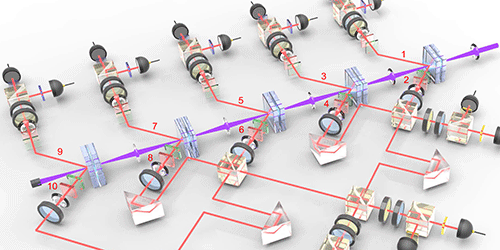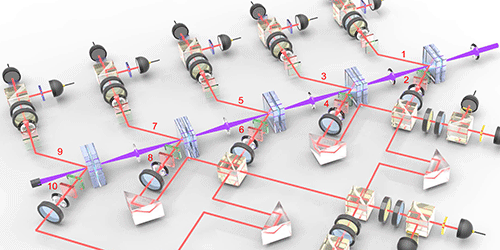Ten Photons in a Tangle
Quantum computing requires multiple qubits entangled together. So far, only a handful of qubits have been coupled together successfully. A new experiment raises the bar with the entangling of ten photons, two more than the previous photon record. While still a ways off from what’s needed to make quantum computers competitive with classical ones, the entanglement of this many photons might be sufficient for certain quantum error correction codes and teleportation experiments.
Entangling photons typically relies on a nonlinear crystal, which converts a small fraction of incoming photons into a pair of entangled photons. In the case of the -barium borate (BBO) crystal, the two photons have opposite polarizations—one being horizontal, the other vertical—and they are emitted in different directions. Researchers therefore use a variety of optical devices to collect the photon pair, which can then be entangled with pairs from other BBO crystals.
Previous multiphoton entanglement experiments had relatively low collection efficiencies of around 40%. Xi-Lin Wang from the University of Science and Technology of China and colleagues have developed a system with 70% collection efficiency. Rather than using a single BBO crystal to create pairs, they utilize two closely spaced BBO crystals separated by a polarization-rotating plate. This “sandwich” configuration generates entangled pairs of photons traveling in the same direction with the same polarization. The boost in efficiency from this output alignment means Wang and colleagues can achieve a high count rate with relatively low input power. To create ten-photon entanglement, the team placed five sandwich structures in a row and illuminated them all with a 0.57-W laser. They then used polarizing beam splitters to combine the photon pairs from each BBO crystal together.
This research is published in Physical Review Letters.
–Michael Schirber
Michael Schirber is a Corresponding Editor for Physics based in Lyon, France.





